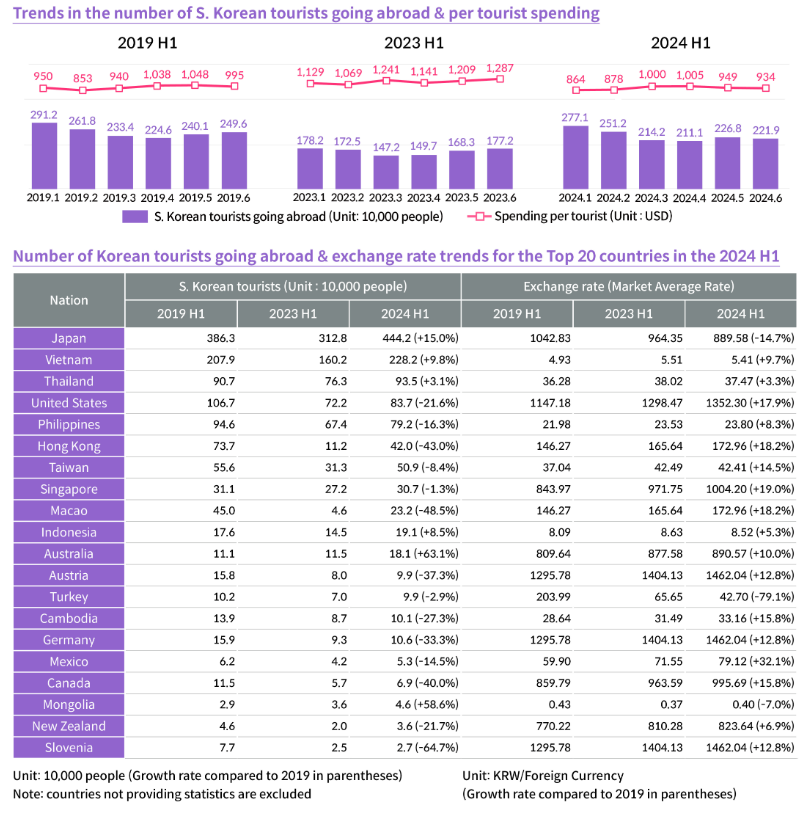Inbound & Outbound tourism in S. Korea in 2024 H1
Foreign tourists visiting S. Korea surged, but their spending fell
·In the 2024 H1, the number of foreign tourists visiting S. Korea reached 7,701,407, recovering to 91.2% of the record high in 2019. This represents a 73.8% increase compared to the 2023 H1.
·The comparison between the 2019 H1 and the 2024 H1 shows that the share of long-distance countries has increased. In the 2024 H1, tourists from the Americas increased by 24.8% compared to that of 2019, while Europe saw a 4.4% increase, Africa a 35.3% increase, and Oceania a 22.2% increase
·The number of tourists from Germany and France increased by 38.6% and 57.1%, compared to the 2019 H1. In the Americas, the number of tourists from the U.S. and Canada grew by 26.2% and 17.6%. Austraila saw a 42.7% increase, boosting the proportion of tourists from Oceania. Yet, in Asia, key countries such as China, Japan, and Thailand saw declines of 20.8%, 13.4%, and 42.9%, respectively, leading to an overall 12.7% decrease in the number of tourists from Asia compared to the 2019 H1.
·Despite the recovery in the number of foreign tourists to S. Korea, their average spending decreased. In the 2024 H1, the average spending per tourist was $1,002, a decline of 18.3% and 37.7% compared to the 2019 H1 and 2023 H1. S. Korea's tourism income in the 2024 H1 increased by only 8.3% compared to the 2023 H1 and remained 25.4% lower than the 2019 H1 (tourism income in the 2019 H1: ~$10.3B; 2023 H1: ~$7.1B; 2024 H1: ~$7.7B)

The number of Korean travelers heading overseas also rose
·In the 2024 H1, the number of Korean tourists traveling abroad reached 14,023,382, a 41.2% increase compared to the 2023 H1, and about 93.4% recovery compared to the record high in the 2019 H1.
·Outbound tourist numbers by country shows varying growth rates. Travelers to Japan and Vietnam increased by 15.0% and 9.8%, while those to Hong Kong decreased by 43.0%. Travel to the U.S., Canada, and Mexico saw declines of 216%, 40.0%, and 14.5%. Travel to Germany and Austria decreased by 33.3% and 37.3%, while travel to Australia increased by 63.1%.
·Despite the increase in outbound tourists, average spending dropped. In the 2024 H1, average spending per tourist was approximately $934, down 3.6% from 2019 and 20.8% from 2023. Consequently, S. Korea's tourism spending increased by 11.8% from 2023 but decreased by 9.9% compared to 2019 (tourism spending in the 2019 H1: ~$14.5B; 2023 H1: ~$11.7B; 2024 H1: ~$13.1B)
Increase tourism income to improve the travel trade deficit
·S. Korea has consistenly recorded a travel trade deficit since 2001, reaching a peak of $14.7B in 2017. Although the deficit decreased afterward, it began to rise again due to the COVID-19 pandemic in 2020. In the 2024 H1, the travel trade deficit reached $5.4B, and this upward trend is expected to continue.
·From 2015 to 2023, the travel trade deficit represented 15~33% of S. Korea's service account deficit, rising to 38.7% in the 2024 H1. Improving this balance is vital for enhancing the service and current account balance. Since reducing domestic tourism spending abroad is unrealistic, attracting foreign tourists visiting Korea to increase tourism income should be the key strategy.
·Japan's case is a valuable reference. Until 2013, about 10 million foreign tourists visit Japan annually, but after promoting inbound tourism, the number rose to 19 million in 2015 and over 30 million in 2018. As a result, Japan's travel trade balance shifted to surplus in 2015 and has remained positive. A national strategic approach could similarly benefit S. Korea's travel trade balance.
